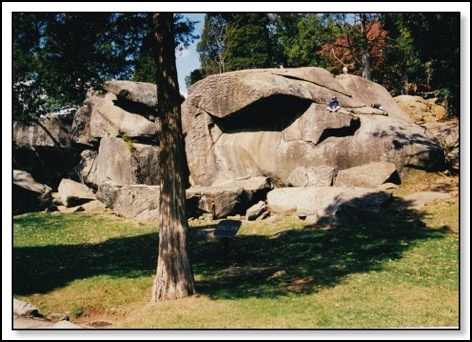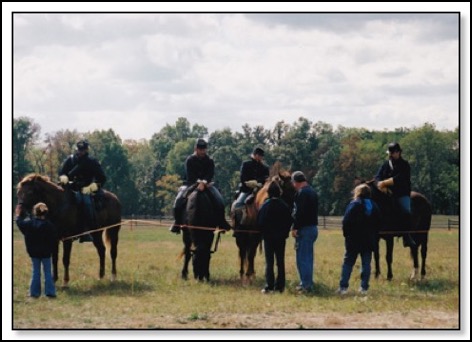Gettysburg at 150, Second Day
02/07/13 09:43 Filed in: History
The second day was the bloodiest day of the three at Gettysburg. The Union soldiers had retreated and dug in on Cemetery Ridge, Little Round Top, and Culp’s Hill. Battles such as at the Peach Orchard, the Wheat field, and Devil’s Den occurred. Following are photos from some of these areas.
Devil’s Den

Soldiers for re-enactments at Gettysburg near the Peach Orchard

Gettysburg, Day 2
James Longstreet’s corps had arrived, and his 20,000 men were sent to outflank the Union left, which was anchored to the south by two eminences known as Little Round Top and Big Round Top. But the Federals had failed to place troops upon those hills, as Lee learned from an early morning reconnaissance report. Ewell was to make a demonstration against Culp’s and Cemetery hills on the Union right and to use his own discretion about launching a full-scale attack.
Longstreet’s men, moving toward their objective, had to reverse, countermarch and take a different route after Brigadier General Lafayette McLaws discovered the planned route would put them in full view of the Federals, negating any advantage of surprise. This cost valuable time but, as events turned out, a Union general was about to present them an unexpected opportunity.
Read More in America’s Civil War Magazine
Subscribe online and save nearly 40%!!!
All but one of Meade’s seven corps were now on the field, deployed in a fish-hook shape with its center along Cemetery Ridge; the defensive positions on Culp’s and Cemetery hills formed the hook at one end. The left was held by Major General Daniel Sickles, who owed his military rank to his political importance in the essential state of New York.
Dissatisfied with his position at the lower end of Cemetery Ridge, he took it upon himself to advance his III Corps nearly a half-mile west toward the Emmitsburg Pike and open high ground in a wheat field near a peach orchard. The move dangerously stretched his 10,000-man corps. Longstreet’s men attacked Sickle’s new position, and the fighting at rocky Devil’s Den, the wheat field and the peach orchard was among the fiercest and bloodiest of the three days.
Meade, faced with Sickles’ blunder, sent V Corps and part of the XI to reinforce him. New York’s Irish Brigade received Last Rites from a Catholic priest before charging into the fray; 198 of them would not return from the desperate fighting in the hot, sultry afternoon.
Above the blood-soaked fields, a similar drama was playing out on Little Round Top. Around 4:30 p.m., men of Alabama, Texas and Arkansas, from John Bell Hood’s Division in Longstreet’s Corps, began ascending the steep hill from the west. Had they arrived two hours earlier, they would have captured the heights unopposed, but by the time they arrived Meade’s chief of engineers, Brig. Gen. Gouveneur K. Warren, had discovered the potentially disastrous situation and sent messages to Sickles, who could not send even a single regiment by that time.
One message found its way to Colonel Strong Vincent, commanding 3rd Brigade, 1st Division, of the Federals’ V Corps. He double-timed his men and deployed them among the rocks and trees of Little Round Top’s western and southern slopes. The fate of the Union Army, at that moment, rested on the shoulders of 1,350 men of the 83rd Pennsylvania, 44th New York, 16th Michigan and 20th Maine regiments. Vincent’s orders were to “hold this ground at all costs!”
Nearly 650 Rebels of the 15th Alabama stormed into the saddle between the Round Tops around 6:00 p.m., and into the muzzles of Colonel Joshua Chamberlain’s 20th Maine. After an hour of intense fighting, Chamberlain’s 300-plus men had nearly exhausted their 15,000 rounds of ammunition. He ordered a countercharge. The surprised Alabamians fell back and attempted to make a stand, but Company B of the 20th Maine, which had been detached to cover the regiment’s flank, and fourteen of Hiram Berdan’s Sharpshooters rose from behind a stone wall and charged the Confederates’ flank. Convinced they were outnumbered, the men of the 15th and 47th Alabama retreated onto Big Round Top.
On the western slope, Colonel Vincent’s other regiments also stood firm until part of the 16th Michigan was pushed back. Gouvenor Warren, receiving a plea for reinforcements, ordered the 140th New York Zouaves to charge, and they broke the Rebels’ line long enough for more reinforcements to arrive.
By the time the sun went down on the second day at Gettysburg, the Union left still held, but III Corps would no longer be a significant factor in the battle, and V Corps had been badly mauled. Meanwhile, a desperate contest was taking place on the slope of Cemetery Hill.
Ewell’s troops had advanced from around the town of Gettysburg to assault Culp’s and Cemetery hills. For an hour they struggled across rough ground while Union batteries threw shot and shell among them, but when they got far enough up the slopes, the Federals could not depress their barrels enough to fire into them, and the Rebels routed infantry of the XI Corps. Union regiments pulled from one area of Cemetery Hill to plug a gap created by the retreat created their own gap, and Confederate infantry poured through.
Down on Cemetery Ridge, Winfield Hancock sent the 14th Indiana and 7th West Virginia regiments to reinforce Cemetery Hill. Arriving after dark, they formed up and charged into the Rebels who were fighting with artillerymen around the Union guns. The Confederates fell back. In one of the ironic events of the war, the 7th West Virginia, which had been the 7th Virginia (Union) until June 20 when West Virginia was admitted as a state, fought hand to hand with the 7th Virginia of the Confederacy, capturing a nephew of their own regimental commander.
The long day of bloodshed finally ended. Meade called together his commanders for a council of war. He’d already sent a message to the War Department stating that he intended to stay and fight; he may have called the council in order to make sure no one would do the next day what Sickles had done. Meade’s army had been attacked on the left and the right; that fact, combined with other intelligence he’d received, led him to believe his center would be the target the next day.
Read more about General Lee’s plan for Gettysburg Day 2
- See more at:
Devil’s Den

Soldiers for re-enactments at Gettysburg near the Peach Orchard

Gettysburg, Day 2
James Longstreet’s corps had arrived, and his 20,000 men were sent to outflank the Union left, which was anchored to the south by two eminences known as Little Round Top and Big Round Top. But the Federals had failed to place troops upon those hills, as Lee learned from an early morning reconnaissance report. Ewell was to make a demonstration against Culp’s and Cemetery hills on the Union right and to use his own discretion about launching a full-scale attack.
Longstreet’s men, moving toward their objective, had to reverse, countermarch and take a different route after Brigadier General Lafayette McLaws discovered the planned route would put them in full view of the Federals, negating any advantage of surprise. This cost valuable time but, as events turned out, a Union general was about to present them an unexpected opportunity.
Read More in America’s Civil War Magazine
Subscribe online and save nearly 40%!!!
All but one of Meade’s seven corps were now on the field, deployed in a fish-hook shape with its center along Cemetery Ridge; the defensive positions on Culp’s and Cemetery hills formed the hook at one end. The left was held by Major General Daniel Sickles, who owed his military rank to his political importance in the essential state of New York.
Dissatisfied with his position at the lower end of Cemetery Ridge, he took it upon himself to advance his III Corps nearly a half-mile west toward the Emmitsburg Pike and open high ground in a wheat field near a peach orchard. The move dangerously stretched his 10,000-man corps. Longstreet’s men attacked Sickle’s new position, and the fighting at rocky Devil’s Den, the wheat field and the peach orchard was among the fiercest and bloodiest of the three days.
Meade, faced with Sickles’ blunder, sent V Corps and part of the XI to reinforce him. New York’s Irish Brigade received Last Rites from a Catholic priest before charging into the fray; 198 of them would not return from the desperate fighting in the hot, sultry afternoon.
Above the blood-soaked fields, a similar drama was playing out on Little Round Top. Around 4:30 p.m., men of Alabama, Texas and Arkansas, from John Bell Hood’s Division in Longstreet’s Corps, began ascending the steep hill from the west. Had they arrived two hours earlier, they would have captured the heights unopposed, but by the time they arrived Meade’s chief of engineers, Brig. Gen. Gouveneur K. Warren, had discovered the potentially disastrous situation and sent messages to Sickles, who could not send even a single regiment by that time.
One message found its way to Colonel Strong Vincent, commanding 3rd Brigade, 1st Division, of the Federals’ V Corps. He double-timed his men and deployed them among the rocks and trees of Little Round Top’s western and southern slopes. The fate of the Union Army, at that moment, rested on the shoulders of 1,350 men of the 83rd Pennsylvania, 44th New York, 16th Michigan and 20th Maine regiments. Vincent’s orders were to “hold this ground at all costs!”
Nearly 650 Rebels of the 15th Alabama stormed into the saddle between the Round Tops around 6:00 p.m., and into the muzzles of Colonel Joshua Chamberlain’s 20th Maine. After an hour of intense fighting, Chamberlain’s 300-plus men had nearly exhausted their 15,000 rounds of ammunition. He ordered a countercharge. The surprised Alabamians fell back and attempted to make a stand, but Company B of the 20th Maine, which had been detached to cover the regiment’s flank, and fourteen of Hiram Berdan’s Sharpshooters rose from behind a stone wall and charged the Confederates’ flank. Convinced they were outnumbered, the men of the 15th and 47th Alabama retreated onto Big Round Top.
On the western slope, Colonel Vincent’s other regiments also stood firm until part of the 16th Michigan was pushed back. Gouvenor Warren, receiving a plea for reinforcements, ordered the 140th New York Zouaves to charge, and they broke the Rebels’ line long enough for more reinforcements to arrive.
By the time the sun went down on the second day at Gettysburg, the Union left still held, but III Corps would no longer be a significant factor in the battle, and V Corps had been badly mauled. Meanwhile, a desperate contest was taking place on the slope of Cemetery Hill.
Ewell’s troops had advanced from around the town of Gettysburg to assault Culp’s and Cemetery hills. For an hour they struggled across rough ground while Union batteries threw shot and shell among them, but when they got far enough up the slopes, the Federals could not depress their barrels enough to fire into them, and the Rebels routed infantry of the XI Corps. Union regiments pulled from one area of Cemetery Hill to plug a gap created by the retreat created their own gap, and Confederate infantry poured through.
Down on Cemetery Ridge, Winfield Hancock sent the 14th Indiana and 7th West Virginia regiments to reinforce Cemetery Hill. Arriving after dark, they formed up and charged into the Rebels who were fighting with artillerymen around the Union guns. The Confederates fell back. In one of the ironic events of the war, the 7th West Virginia, which had been the 7th Virginia (Union) until June 20 when West Virginia was admitted as a state, fought hand to hand with the 7th Virginia of the Confederacy, capturing a nephew of their own regimental commander.
The long day of bloodshed finally ended. Meade called together his commanders for a council of war. He’d already sent a message to the War Department stating that he intended to stay and fight; he may have called the council in order to make sure no one would do the next day what Sickles had done. Meade’s army had been attacked on the left and the right; that fact, combined with other intelligence he’d received, led him to believe his center would be the target the next day.
Read more about General Lee’s plan for Gettysburg Day 2
- See more at:
blog comments powered by Disqus

